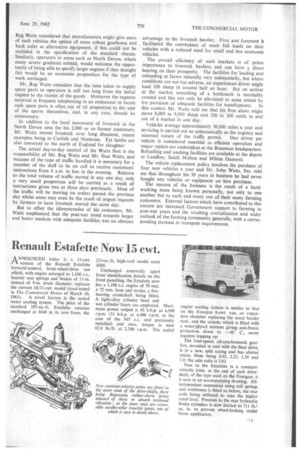Renault Estafette Now 15 cwt.
Page 77

If you've noticed an error in this article please click here to report it so we can fix it.
AANNOUNCED today is a 15-cwt. version of the Renault Estafette forward-control, front-wheel-drive van which, with engine enlarged to 1,108 c.c., heavier rear springs and brakes of 11-in. instead of 9-in. drum diameter, replaces the current 10/12-cwt. model (road-tested in The Commercial Motor of March 10,
1961). A novel feature is the sealed water cooling system. The price of the standard 187-cu.-ft. Estafette remains unchanged at £648 in its new form; the 215-cu.-ft. high-roof model costs £688.
Unchanged externally apart from identification details on the front panelling, the Estafette now has a 1,108 c.c. engine of 70 mm. x 72 mm. bore and stroke, a fivebearing crankshaft being fitted. A light-alloy cylinder head and wet cylinder liners are employed. Maximum power output is 45 b.h.p. at 4,500
r.p.m. (31 b.h.p. at 4,400 r.p.m. in the ease of the 845 c.c. unit previously installed) and max. torque is now 65.8 lb./ft. at 2,200 r.p.m. The sealed engine cooling system is similar to that on the Fottrgon 6-cwt. van, an expansion chamber replacing the usual header tank, and the system, which is filled with a water/glycol mixture giving anti-freeze protection down to —40° C., never requires topping up.
The four-speed, all-synchromesh gearbox, mounted in unit with the final drive, is in a new, split casing and has altered ratios, these being 4.02, 2.25, 1.39 and 1.0; the axle ratio is 5.83.
New to the Estafette is a constantvelocity joint, at the end of each driveshaft, of the type used on the Fourgon; it is seen in an accompanying drawing. Allindependent suspension using coil springs and wishbones is fitted as before, the rear coils being stiffened to take the higher rated load. Pressure to the rear hydraulic brake cylinders is now limited to 711 lb./ sq. in. to prevent wheel-locking under fierce application.
















































































































































